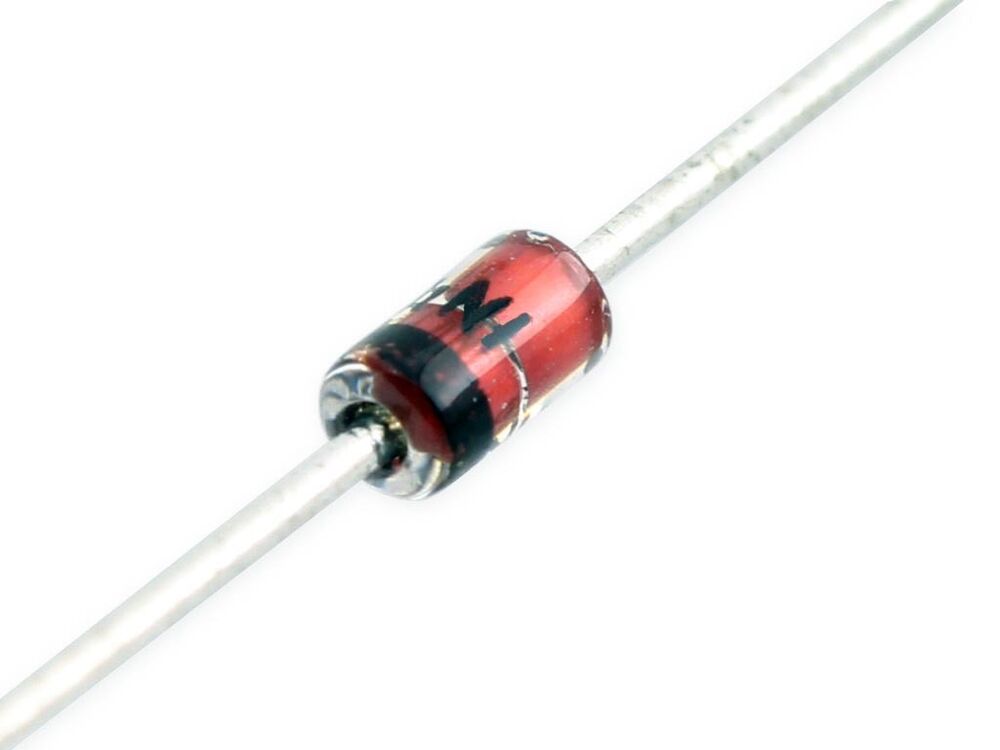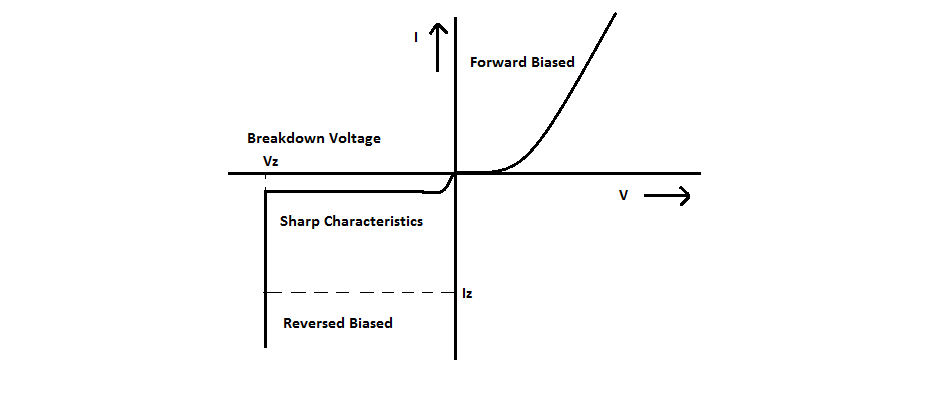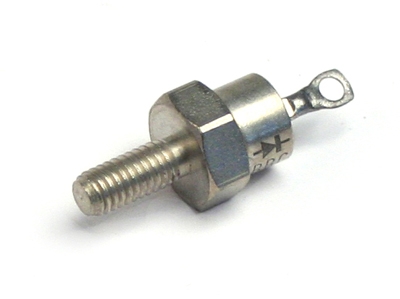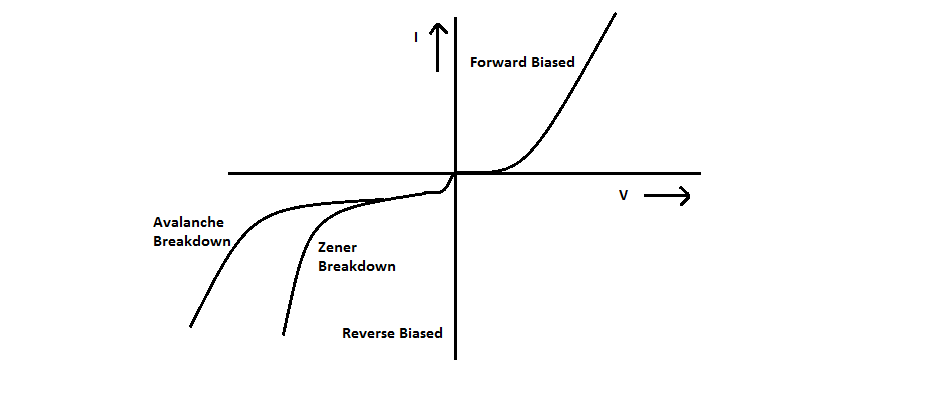A diode is an electronic component that consists of two electrodes. These two electrodes are the positive electrode and the negative electrode. These diodes are composed of semiconductor materials like germanium, silicon, and selenium. The most important property of diodes is that they are capable of conducting current in one direction only. Diodes are used as voltage regulators, switches, rectifiers, etc. A PN junction diode is a type of diode that has a negative side (n) and a positive side (p). PN junction diodes are made by adding impurities to the two sides of the semiconducting material of the diode. Two such PN junction diodes are Zener Diode and Avalanche Diode. This article discusses an overview of Zener breakdown and avalanche breakdown.
Zener Breakdown and Avalanche Breakdown
In a basic semiconductor, a junction is formed due to the interaction between p-type and n-type. This junction can be dope heavily or lightly based on circumstances. As it is already known that a basic diode that is of junction p-n can conduct during forwarding bias.
Once the stage of reverse bias is entered it cannot conduct and some breakdowns arise. These are mainly due to the multiplication of the carriers as well as due to the doping concentration made high at the junction. There are two types of breakdown
- Avalanche Breakdown
- Zener Breakdown
What is the Zener Diode?
Zener diode is quite similar to a normal PN junction diode but it mainly works in the reverse-biased state. However, when an ordinary PN junction diode is connected in reverse biased condition, it is a Zener diode. A Zener diode is nothing but a PN junction diode that has been heavily doped. Such a diode has been specially designed for various important applications.

Zener Diode
When a Zener diode is forward biased, it will operate like ordinary diodes. However, when the PN junction diode is in reverse biased condition, the depletion layer of the diode will become wider. If we continue to increase the reverse-biased voltage, the depletion layer of the diode will become broader. There will also be a constant reverse saturation current because of the minority carriers.
As the reverse voltage is continued to be applied across the junction of the diode, the minority carriers will acquire sufficient kinetic energy because of the strong electric field. Free electrons will collide with the stationary ions present in the depletion layer and generate more free electrons. The newly generated electrons will also acquire sufficient kinetic energy and they will also generate more electrons. Because of this phenomenon, a huge number of free electrons will be generated, and the diode will become conductive.
What is the Zener Breakdown?
When a reverse-biased voltage is applied across the terminals of a highly doped PN junction diode, immediately the depletion region of the diode will begin to expand. Because of this voltage, a large number of carriers electrons and holes will be generated. The depletion region has electrons on one side and holes on the other side.
These charge carriers will help to create a very powerful electric field across the diode’s junction. The magnitude of the generated electric field will depend on the magnitude of the reverse voltage applied. As the reverse-biased voltage is increased, the magnitude of the generated electric field will also increase.

Zener Breakdown
This electric field will start to exert a force on the electrons which are present in the valence band. It will start to pull the electrons in the higher energy band which is also known as the conduction band. In this way, a huge number of electrons will enter the conduction band and help in the conduction process.
This process is called Zener breakdown and it has numerous applications.
What is an Avalanche Diode?
An avalanche diode is basically a type of diode which has been designed to cause avalanche breakdown at a particular reverse bias voltage. The PN junction of the avalanche diode is designed in such a way that it prevents current concentration so that the diode remains undamaged by avalanche breakdown.

Avalanche Diode
The avalanche diode is constructed in a way similar to that of the Zener diode, and both Avalanche breakdown, as well as Zener breakdown, are present in an avalanche diode. Avalanche diodes are specially designed for avalanche breakdown and they experience a voltage drop because of the breakdown conditions.
Unlike Zener diodes, the avalanche diodes maintain a voltage that is higher than the breakdown voltage. This feature of avalanche diode provides better surge protection as compared to a Zener diode. An avalanche diode has a small positive temperature coefficient of voltage.
What is Avalanche Breakdown?
In a PN junction device, the free electrons move across the depletion region. As a result, they possess velocity and because of this, these electrons will also possess kinetic energy. The minority charge carriers will randomly move inside the semiconductor device because of their velocity. These electrons will collide with other stationary electrons that are tightly held to the atom because of covalent bonding.
The bound electrons will break the covalent bond and help in the process of conduction by moving into the conduction band. This occurs due to the high-velocity electrons that are moving in the depletion region. These electrons transfer some of their kinetic energy to the stationary electrons causing them to move.

Avalanche Breakdown
This causes the stationary electrons to move towards the conduction band. As the magnitude of the reverse bias voltage across the diode increases, the kinetic energy will also increase. This will cause more and more electrons to collide with one another resulting in the generation of current. This high current can cause the breakdown of the diode. This phenomenon is also called Avalanche Breakdown.
Differences Between Zener Breakdown and Avalanche Breakdown
Both the Zener and the avalanche breakdowns occur in the reverse biasing stage. The Zener breakdown’s voltage is comparatively lesser than the breakdown of an avalanche. The basic differences of both the breakdowns can be listed as follows.
|
Avalanche Breakdown |
Zener Breakdown |
|
(1) The reason behind the occurrence of this breakdown is mainly due to the collision that takes place between the carriers. |
(1) The reason here behind this breakdown is due to the high intensity of the electric field. |
|
(2) The region of the depletion region is thick enough. |
(2) The width of the region of depletion is thin. |
|
(3) The concentration of doping at the junction is at the minimum. |
(3) The concentration level of doping is high at the junction. |
|
(4) Focused on the production of a pair of electrons and holes. |
(4) Mainly the production of electrons focused here. |
|
(5) The intensity of the electric field is low. |
(5) The intensity of the electric field is strong enough. |
|
(6) The coefficient of temperature is of positive value. |
(6) The coefficient of temperature is of negative value. |
|
(7) The ionization that occurred here is due to the influence of the collision effect. |
(7) The ionization in this breakdown is due to the strong intensity of the electric field. |
|
(8) The breakdown voltage and the temperature are directly related to each other. |
(8) The breakdown voltage and the temperature are inversely related to each other. |
|
(9) Once the breakdown has occurred the voltage tends to vary. |
(9) The occurrence of breakdown doesn’t affect the voltage. |
|
(10) Once it undergoes the breakdown the junction gets destroyed completely it cannot retain back its position. |
(10) As the reverse voltage is removed from the diode the junction gets back to its normal position. |
Key Differences between Zener and Avalanche Breakdown
The key differences between Zener and avalanche are discussed below.
- The main difference lies in the operation of the two diodes. Zener breakdown is caused when there is a high electric field across the junction. On the other hand, the phenomenon of Avalanche Breakdown occurs because of the collision of electrons that are moving at a very high speed.
- Another difference lies in the nature of doping. Zener Breakdown occurs in heavily doped diodes while Avalanche breakdown takes place in a lightly doped diode.
- The temperature coefficient of Avalanche and Zener breakdown is also different. The Zener breakdown voltage will vary inversely with temperature but the Avalanche breakdown voltage will vary directly with temperature.
- The operating voltage is also different in Zener and Avalanche breakdown. Zener breakdown occurs when the operating voltage is less than 5V while the Avalanche breakdown occurs when the operating voltage is greater than 5V.
- Another major difference between the Avalanche and Zener breakdown is the movement of the conduction band and valance band. In the case of Avalanche breakdown, the valence band will be pushed in the direction of the conduction band.
Please refer to this link to know more about Avalanche Photodiode MCQs Zener Diode MCQs
Hence in this way, the analysis for the types of breakdown is done. Both the breakdowns have their own standards. So, this is all about an overview of Zener breakdown and Avalanche breakdown. We came to know about the functions of these diodes. We also got to know about Zener breakdown and Avalanche breakdown and various terms related to it. Can you mention a few applications of Zener Diode?